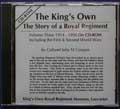 |
King's Own Royal Regiment Museum Lancaster |
|||||||||||||||||
|
HOME Museum & Collections Soldiers of the Regiment Sales Donations Events Contact Us REGIMENTAL HISTORY 17th Century 18th Century 19th Century 20th Century First World War Second World War Actions & Movements Battle Honours FAMILY HISTORY Resources Further Reading PHOTO GALLERY ENQUIRIES FURTHER READING LINKS |
Regimental History - 20th Century 1st Battalion, King's Own Royal Regiment, Lancaster At the outbreak of the war the 1st Battalion was in Karachi, India, and were involved with internal security duties. In April 1941 350 officers and men were airlifted to Iraq and took part in action at the RAF air station at Habbaniya against pro-German Iraqi forces under Raschid Ali who had just come to power following a coup d'etat. Between 19th and 22nd May 1941 the battalion saw action at Fallujah which defeated the Iraqis and opened the road to Baghdad. The battalion remained in Iraq as part of the occupying force until May 1942 when it was transferred to the Western Desert. In June 1942 the Battalion was on the Libyan-Egyptian Frontier, until ordered to fall back to Mersa Matruh. On 29th June the Battalion was ordered to break out towards Fuka airfield and El Alamein. Many were killed or wounded during the withdrawal. Those remaining left Alexandria for Cyprus on 17th August on board the troop ship Princess Marguerite which was torpedoed en-route. The battalion eventually reached Cyprus as was made up to strength with men from the 1st Battalions of the South Wales Borderers and the Duke of Cornwall's Light Infantry. After training in Cyprus, Syria and Palestine the battalion was sent to the Greek island of Leros on 5th November 1943. Deprived of air cover the King's Own, along with three other infantry battalions, were subject to a German airborne and sea landing on 12th November. After only a few days of fierce fighting the island was forced to surrender. Only a handful of men escaped - more than fifty were killed and an unknown number wounded and taken prisoner. The handful who escaped made it to Palestine and what was left of the 1st Battalion was merged with the 8th Battalion King's Own, and the unit retained the title of the 1st Battalion. The new 1st Battalion landed in Italy on 28th March 1944 and operated as part of the 10th Indian Division. They were in the Tiber Valley in June, captured the village of Montone in July and took part in a night attack which opened the road to Citta di Castello. In October 1944 the Battalion fought in the Adriatic sector, taking San Martino, followed by heavy fighting to secure and retain Pideura Ridge, west of Faenze in December 1944. The battalion was resting at Ferrar in Northern Italy when the campaign ended on 2nd May 1945. September 1939 Battalion moves to Karachi Following the outbreak of war in Europe the 1st Battalion moved from Madras to Karachi, then in India and now in Pakistan. They began duties associated with coastal defence and internal security. There was also intensive periods of training in readiness for future action. 15th April 1941 – 23rd April 1941 Move from India to Iraq Following a pro-German coup in Baghdad, Iraq, under Raschid Ali, British forces in Palestine were put on standby to move to Iraq to protect British Royal Air Force bases. Troops in Palestine could not be released and 1st King's Own was flown from India to Iraq - the first tactical movement of troops in war time. The battalion flew in stages from India - along the Gulf to Shaibah in Iraq. With the RAF base at Habbaniya under threat - the battalion arrived - on it's Regimental Day - St. George's Day - 23rd April. 28th April 1941 In Baghdad Raschid Ali declares war on Britain 1st May 1941 – 10th May 1941 Battle at RAF Habbaniya On 1st May 1941 Iraqi forces surround the RAF station at Habbaniya. 1st King's Own and the RAF combine forces to improve defences of the station. There are no heavy weapons and most of the equipment is old and not up to the Iraqi enemy. Two First World War artillery pieces, located outside Air Force House, are brought back into use. 1st King's Own comes into contact with Iraqi forces on 6th May and a battle on land in the air takes place. The Iraqi forces are held but victory is not to hand. 10th May 1941 – 20th May 1941 Action at Fallujah After the defeat of the Iraqi forces at Habbaniya, 1st King's Own move out of the air station and head to Baghdad - coming in to contact with the enemy at Fallujah. The battalion face stiff resistance at Fallujah - but defeat the Iraqi forces. A couple of days later the threat from Baghdad is over and Raschid Ali flees. Iraq remains pro-British and an important air transit route and source of oil remains in Allied hands.
22nd May 1941 - May 1942 Internal Security Duties in Iraq 28th May 1942 Move from Iraq to Egypt The battalion moves to Egypt and the Division goes straight into battle. 1st Battalion are moved to a plateau overlooking Sollum Bay near the Libyan-Egyptian Border. The situation in the Western Desert does not look good for the Allies. 16th June 1942 – 21st June 1942 Retreat from Sollum Field Marshal Rommel's Afrika Corps launched it's attack eastward on 26th May 1942 and quickly pushed forward. Recently arrived 1st King's Own took up a defensive position called 'Sollum Box'. With the ever-increasing German threat the battalion began to fall back along the Mediterranean coast. 22nd June 1942 – 28th June 1942 Positions held at Mersa Matruh The 1st Battalion continues its withdrawal and falls back to Mersa Matruh, a small Egyptian town on the coast - over sixty years later an Egyptian holiday resort with little sign of the battle which raised the town to the ground. 1st King's Own took over the same positions occupied by 2nd Battalion King's Own when they had been at Mersa Matruh in 1940! 29th June 1942 – 1st July 1942 Mersa Matruh to El Alamein With the German forces advancing across the desert - the 1st Battalion fall back from Mersa Matruh, through the airfield at Fuka, to the railway station at El Alamein. It was here that the battalion re-organised, established it's losses - many men were killed, wounded or had been taken prisoner. Major Walton reformed the battalion on the 1st July and the line held. 1st July 1942 – 6th July 1942 The holding of El Alamein On the 1st July the battalion held it's position on the El Alamein defensive line - less than one hundred miles away from the major Port of Alexandria. By the 4th July the British position was stronger and the line was still holding. Egypt did not fall and the defensive line chosen by Major General Ritchie - who had commanded the 2nd Battalion King's Own in Palestine just prior to the war - proved to be the best position. 17th August 1942 HMT Princess Marguerite torpedoed 1st King's Own, as part of the 10th Indian Division, was sent to Cyprus on garrison duty. The battalion left Port Said on the morning of 17th August 1942. The convoy consisted of three destroyers, one armed merchant man and HM Troopship Princess Marguerite - containing divisional headquarters, 1st King's Own and about 500 Indian troops. At 3.10pm on the same day Princess Marguerite was torpedoed by an enemy submarine; one of the oil tanks exploded and caught fire in a few seconds and the ship rapidly started to sink. Five minutes after she was hit the order was given to abandon ship, but owing to the flaming decks it was only possible to lower five life boats. The destroyer HMS Hero was detailed to pick up survivors - by 3.30pm most of the troops were in the water - swimming towards Hero. Ten minutes later Princess Marguerite gently rolled over and sank. The loss of life amounted to sixty - King's Own casualties being one officer and 23 other ranks. The submarine was never seen - although a search continued until midday on the 18th. Hero deposited her unexpected passengers once more on the quays at Port Said. Private William J Crellin distinguished himself during the sinking of the ship and his story is told in a Victor comic. Roll of Honour - 1st Battalion, King's Own, HMT Princess Marguerite, August 1942 27th August 1942 Arrival in Cyprus The 1st Battalion eventually reach Cyprus on 27th August 1941 and moved into barracks at Dhekelia. There now followed the amalgamation of three depleted units - 1st King's Own, 1st Duke of Cornwall's Light Infantry and 1st South Wales Borderers joined together. They took the title of the senior unit - The King's Own. September 1942 - October 1942 Cyprus Duties From early September 1942 the battalion took part in intensive training - concentrating on exercises which would repel a not unlikely attack on the island. Nicosia War Cemetery, Second World War 14th November 1942 Tragedy of SS Scillin On the night of 14th November 1942 the Italian transport ship SS Scillin was sunk by the British submarine P212, unaware of its passengers on board. The Scillin was sailing from North Africa to Italy with 810 British prisoners and 200 Italian soldiers on board. After protests from medical officer, Captain Gilbert, a further 200 prisoners had been removed before sailing. Men from the 1st Battalion King's Own - captured in the Western Desert - were amongst those on board. The conditions in the hold were terrible. It was so crowded no-one could lie down. About half the men had dysentery and a great many were seasick. The only air and light came in through a small hatch. It was kept open during the day and battened down at night. When sighted by P212 the ship was in darkness. It seemed to be heading towards Africa and carried no sign or flag. The submarine's orders were that only African-bound ships were to be torpedoed. P212 opened fire with its 3 inch gun as a signal to stop. The Scillin ignored the warning and sent a wireless transmission that it was under attack. At 19.50 a torpedo was fired and the Scillin sank immediately. Private McLean, a prisoner, managed to climb on to the deck and witnessed the Italian soldiers trying to keep the hatches closed until the last minute. Once the torpedo hit, the soldiers made for the rafts as quickly as possible. Some 24 Prisoners of War and 35 Italians, including the Captain of the Scillin, were rescued by the submarine. P212 then had to leave the area as an enemy vessel approached. "It is known that the torpedo blew the bottom out of the hold in which the British were herded and that they died instantly." Official Log of P212, November 1942. The Commander of the submarine was absolved of any blame. After the war the case was investigated as a war crime. The Scillin had no life-belts or life-boats and the hatch had been battened down. However, the charge of the murder of 783 prisoners was dropped in January 1947 due to lack of evidence. Roll of Honour - 1st Battalion, King's Own, SS Scillin, November 1942 5th November 1943 Arrival on Leros With the surrender of the Italian army - the Greek islands fell from Axis control. On 5th November 1943 the 1st Battalion moved from Palestine and arrived on the island of Leros between Greece and Turkey. 12th November 1943 – 16th November 1943 Action on Leros On 12th November the King's Own and three other battalions on the island of Leros were subjected to German airborne and sea landings. This was the last major German parachute attack of the war. The British soldiers were in a desperate situation. There was no hope of air cover to protect them - it had been ordered elsewhere. After four days of fierce fighting the island surrendered. The 1st Battalion was virtually wiped out. Only about 58 men of the King's Own managed to escape from the island to Palestine. Many were taken prisoner - an unknown number were left dead and wounded. The whole operation had proved disastrous and a tremendous waste of men.
30th January 1944 8th and 1st Battalions merge The handful of survivors of Leros had made their way back to Palestine - and joined with the 8th Battalion King's Own who had moved there from Malta, via Egypt. It was decided to merge the 1st Battalion with the 8th - and reform a new 1st Battalion. This took place, with the permission of the Colonel of the Regiment - on 30th January 1944. The new battalion remained part of the 25th Infantry Brigade of the 10th Indian Division. Find out more:
Only a proportion of our collections are on display at anyone time. Certain items are on loan for display in other institutions. An appointment is required to consult any of our collections which are held in store. |




